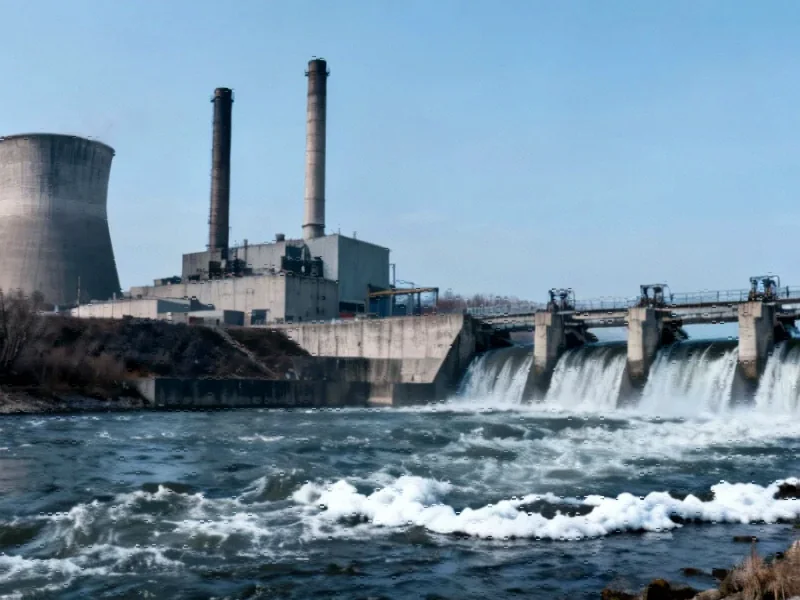The Temperature Paradox in Green Hydrogen Production
As the world races toward sustainable energy solutions, green hydrogen production through water electrolysis has emerged as a critical technology. However, a fundamental challenge has plagued researchers: why do high-performance catalysts often degrade unexpectedly under industrial operating conditions? A groundbreaking study published in Nature Communications reveals a temperature-dependent mechanism evolution in RhRu3Ox catalysts that could reshape our understanding of acidic water oxidation.
The research demonstrates that binary metal oxide catalysts exhibit dramatically different behaviors depending on operating temperature. At room temperature, RhRu3Ox achieves exceptional performance with an overpotential of only 184 mV at 10 mA cm⁻² and stability exceeding 200 hours—significantly outperforming conventional RuO2, which fails within 50 hours. When integrated into proton exchange membrane water electrolyzers (PEM-WE), the catalyst maintained industrially relevant current densities of 200 mA cm⁻² for over 1000 hours at room temperature.
The Synthesis Breakthrough Behind Advanced Catalysts
Researchers developed a sophisticated three-step synthesis method to create the binary metal oxide structure. The process begins with wet-impregnation of precursor salts on carbon black structural promoters, followed by reduction at 900°C in an H2/Ar atmosphere to form alloy nanoparticles. The structural promoter plays a crucial role in preventing catalyst agglomeration at high temperatures, thereby maximizing specific surface area.
The second step involves annealing at 450°C in air to remove carbon species and oxidize the alloy into the corresponding binary metal oxide. Finally, acid leaching in 1M HCl eliminates unstable components, yielding the optimized MRuO structure. Through systematic screening of platinum group elements, RhRuO emerged as the optimal composition.
This sophisticated manufacturing approach represents significant progress in chemical synthesis methodologies that are transforming materials science.
Structural and Electronic Characteristics
Advanced characterization techniques revealed critical insights into the catalyst’s superior performance. Transmission electron microscopy showed RhRuO particles averaging just 4.4 nm in size—significantly smaller than commercial RuO2 counterparts. The exposed facets with Miller indices of {110} and {10} along the [001] orientation provide optimal active sites for the oxygen evolution reaction.
Energy dispersive spectroscopy mapping confirmed uniform distribution of Ru and Rh elements throughout the structure. The Brunauer-Emmett-Teller method determined a substantial specific surface area of 197.1 m² g⁻¹, while electrochemical capacitance measurements revealed an electrochemically active surface area nearly five times larger than commercial RuO2.
X-ray photoelectron spectroscopy and X-ray absorption spectroscopy studies uncovered crucial electronic structure modifications. RhRuO exhibited slightly negative shifts in Ru 3d binding energies, indicating the lowest Ru oxidation state among the tested catalysts. This electronic configuration, combined with the material’s nanoscale architecture, creates ideal conditions for efficient water oxidation.
The Temperature-Dependent Mechanism Revelation
The most significant finding emerged from operando studies using a temperature-controlled electrochemical reactor coupled with a mass spectrometer. Isotope labeling experiments revealed that RhRu3Ox follows the adsorbate evolution mechanism (AEM) at room temperature—a relatively stable pathway. However, as temperatures increase to industrial operating conditions, the lattice oxygen evolution mechanism (LOM) emerges, compromising catalyst stability.
This temperature-dependent mechanism evolution explains why many promising laboratory catalysts fail in real-world applications. The research provides the first direct evidence of how operating temperature fundamentally alters the reaction pathway in Ru-based catalysts.
These findings have profound implications for industrial automation systems that must account for such mechanistic changes in catalyst design and operation.
Performance Metrics and Industrial Validation
In rigorous testing, RhRuO demonstrated exceptional electrochemical performance with a Tafel slope of 54.7 mV/decade—significantly lower than homogeneous RuO2 (58.1 mV/decade) and commercial RuO2 (66.4 mV/decade). Electrochemical impedance spectroscopy revealed the lowest charge transfer resistance, indicating superior reaction kinetics.
Temperature-dependent studies provided even more compelling evidence of RhRuO’s advantages. The apparent activation energy of RhRuO measured just 10.9 ± 0.5 kJ mol⁻¹—approximately one-quarter that of homogeneous RuO2 (46.7 ± 3.7 kJ mol⁻¹). This dramatically reduced energy barrier explains the catalyst’s exceptional performance across temperature ranges.
When tested in practical proton exchange membrane water electrolyzer configurations, RhRuO required only 1.76V to achieve 500 mA cm⁻² at room temperature, significantly outperforming comparison catalysts. Most impressively, the catalyst maintained stable operation for 1000 hours at 200 mA cm⁻²—a critical milestone for industrial adoption.
Techno-Economic Analysis and Future Applications
The research team conducted comprehensive techno-economic analysis based on industrial-scale pilot data and International Renewable Energy Agency cost models. Using the global weighted average levelized cost of electricity for solar photovoltaic ($0.049 kWh⁻¹) at industry-relevant current density (0.2 A cm⁻²), the analysis confirmed the economic viability of RhRuO-based hydrogen production.
This breakthrough comes amid broader manufacturing innovations that are transforming industrial processes across multiple sectors.
The understanding of temperature-dependent mechanisms opens new avenues for catalyst design. By engineering materials that maintain stable reaction pathways across operational temperature ranges, researchers can develop next-generation catalysts specifically optimized for industrial conditions. This approach could significantly reduce the cost of green hydrogen production, accelerating the transition to sustainable energy systems.
Broader Implications for Energy Technology
This research transcends immediate applications in water electrolysis, offering fundamental insights into catalyst behavior under varying thermal conditions. The methodology combining operando spectroscopy with temperature-controlled reactors provides a template for future catalyst development across multiple chemical processes.
The findings also highlight the importance of system reliability considerations in energy infrastructure design, where understanding failure mechanisms is crucial for long-term operation.
As the energy sector continues to evolve, such detailed mechanistic understanding will be essential for designing robust, efficient systems. The research demonstrates how atomic-level engineering, combined with sophisticated characterization techniques, can solve practical industrial challenges in renewable energy technologies.
These developments in catalyst technology are part of larger technological transformations occurring across multiple industries, where advanced materials and AI-driven design are creating new possibilities.
The temperature-dependent mechanism evolution discovery represents a paradigm shift in catalyst design philosophy, emphasizing the need to consider operational conditions throughout the development process rather than optimizing solely for laboratory performance metrics.
Looking forward, the principles uncovered in this study could influence advanced manufacturing approaches across multiple clean technology sectors, potentially accelerating the development of efficient energy storage and conversion systems.
This article aggregates information from publicly available sources. All trademarks and copyrights belong to their respective owners.
Note: Featured image is for illustrative purposes only and does not represent any specific product, service, or entity mentioned in this article.



